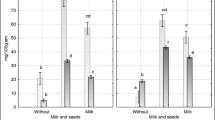Abstract
The objective of study was to select and characterize different food ingredients of plant origin and to optimize different levels of their formulations to develop nutrient bars; stable on storage and specific to women at risk of osteoporosis. After intensive literature review, ingredients selected include-cereal-mix of brown rice, oats and corn flakes, defatted soy flour, dried fruit mix of figs, dates and golden raisins, flaxseeds, two herbs namely dandelion leaves (Taraxicum officinale) and basil (Ocimum basilicum), honey and rice bran oil. Out of the 6 trials, total of 24 formulations were prepared to develop the bars. Tin moulds were used to shape and bake the bars, with standard temperature observed at 125 ± 5 °C for 25 ± 5 min. Selected ingredients showed high nutritional score on proximate and other nutrient analysis; four formulations of trail-VI got higher scores and were microbiologically safe. However, product showed some oxidative changes on storage. It was concluded that functional foods with healthy nutrients prepared for women at risk of osteoporosis not only aid in their bone health but are also commercially viable.


Similar content being viewed by others
References
AOAC (1995) Official methods of analysis, 16th edn. Association of Official Analytical Chemist, Virginia, USA
AOAC (2012) Official methods of analysis, 19th edn. Association of Official Analytical Chemist, Washington DC, USA
AOAC (Association of official analytical chemists) (1996) Official methods of analysis. AOAC, Arlington, Supplement March
AOAC International (2005) Official methods of analysis. 18. AOAC international; Gaithersburg, MD: Method 2001.10
AOCS (1973) Official and tentative methods, 3rd edn. American Oil Chemical Society Chicago, Illinois. Ca 54–40, Ed 8–53
Arjmandi BH, Hooshmand S, Chai SC et al (2011) Comparative effects of dried plum and dried apple on bone in postmenopausal women. Br J Nutr 106:923–930. https://doi.org/10.1017/S000711451100119X
Bourne MC (1978) Texture profile analysis. Food Technol 32:63–66
Caroline da Silva E (2013) Stability of cassava flour-based food bars. Food Sci Technol 33(1):192–198. https://doi.org/10.1590/S0101-20612013005000025
Chen Y, Ho S, Lee R et al (2001) Fruit intake is associated with better bone mass among Hong Kong Chinese early postmenopausal women. J Bone Miner Res 16(S1):S386
Coelho KD (2006). Development and evaluation of acceptance of morning cereals and amaranth-based cereal bars (Amaranthus cruentus L.) Masters Thesis. USP, São Paulo- SP, Brazil
Freitas DGC, Moretti RH (2006) Characterization and sensory evaluation of functional cereal bars with high protein and vitamin content. Ciênc Tecnol Aliment 26(2):318–324
Garg N, Garg KL, Mukerji KG (2010) Laboratory manual of food microbiology. I.K. international publishing house private limited, New Delhi, p 111
Harris W (2010) Omega-6 and omega-3 fatty acids: partners in prevention. Curr Opin Clin Nutr Metab Care 13(2):125–129
Higgs J, Derbyshire E, Styles K (2017) Nutrition and osteoporosis prevention for the orthopaedic surgeon: a wholefoods approach. EFORT Open Rev 2(6):300–308. https://doi.org/10.1302/2058-5241.2.160079
Hooshmand S, Kern M, Metti D et al (2016) The effect of two doses of dried plum on bone density and bone biomarkers in osteopenic postmenopausal women: a randomized, controlled trial. Osteoporos Int 27:2271–2279
IOF—International Osteoporosis (2017) What is osteoporosis? https://www.iofbonehealth.org/what-is-osteoporosis. Last Accessed 01 June 2017
Johnson CD (2011) Nutritional compositions and methods for treating or preventing osteoporosis—IP Australia, AU2011265567.2011
Larmond E (1970) Methods of sensory evaluation of food. Can Deptt Agric Pubs: 1284
Lee J (2014). Effect of Calcium-fortified cereal bars on dietary calcium intake in women.ClinicalTrials.gov Identifier: NCT01508689
Macdonald H, Downie F, More F et al (2001) Higher intakes of fruit and vegetables are associated with higherbone mass in perimenopausal Scottish women. Proc Nutr Soc 60:202A
Maggio M, Artoni A, Lauretani F, Borghi L, Nouvenne A, Valenti G, Ceda GP (2009) The impact of omega-3 fatty acids on osteoporosis. Current Pharmaceutical Design 15(36):4157–4164
Matsuura FCAU (2005) Study of maracuja albedo and its utilization in cereal bar. PhD Thesis, UNICAMP, Campinas, SP, Brazil
Mridula D, Singh KK, Barnwal P (2013) Development of omega-3 rich energy bar with flaxseed. J Food Sci Technol 50(5):950–957
Nadeem M, Salim-ur-Rehman Anjum F M et al (2012) Development, characterization, and optimization of protein level in date bars using response surface methodology. Sci World J 2012:1–10
Padmashree A, Sharma GK, Srihari KA et al (2012) Development of shelf stable protein rich composite cereal bar. J Food Sci Technol 49(3):335–341. https://doi.org/10.1007/s13197-011-0283-6
Padmashree A, Sharma GK, Govindaraj T (2013) Development and evaluation of shelf stability of Flaxoat nutty bar in different packaging materials. Food Nutr Sci 4:538–546
Shearer MJ (2000) Role of vitamin K and Gla proteins in the pathophysiology of osteoporosis and vascular calcification. Curr Opin Clin Nutr Metab Care 3:433–438
Silva de Paula N, Natal DIG, Ferreira HA et al (2013) Characterization of cereal bars enriched with dietary fiber and omega 3. Child Nutr 40(3):269–273. https://doi.org/10.4067/s0717-75182013000300009
Tarledgis BG, Watts BM, Younathan MJ et al (1960) A distillation method for the qualitative determination of malonaldehyde in rancid food. J Am Oil Chem Soc 37(1):44–48
Weber P (2001) Vitamin K and bone health. Nutrition 17:880–887
Yang F, Xu MR, Yang MF et al (2005) Patterns of the use of traditional Chinese medicines in the treatment of osteoporosis. Chin J Clin Rehabil 9(31):203–205
Zaid SSM, Sulaiman SA, Othman NH et al (2012) Protective effects of Tualang honey on bone structure in experimental postmenopausal rats. Clinics (Sao Paulo). https://doi.org/10.6061/clinics/2012(07)13
Acknowledgements
We are highly thankful to all the staff of Department of Food and Nutrition and Department of Food Science and Technology of Punjab Agricultural University, for their support and assistance in the study.
Author information
Authors and Affiliations
Corresponding author
Additional information
Publisher's Note
Springer Nature remains neutral with regard to jurisdictional claims in published maps and institutional affiliations.
Rights and permissions
About this article
Cite this article
Munshi, R., Kochhar, A. & Kaur, A. Nutrient selection and optimization to formulate a nutrient bar stable on storage and specific to women at risk of osteoporosis. J Food Sci Technol 57, 3099–3107 (2020). https://doi.org/10.1007/s13197-020-04343-3
Revised:
Accepted:
Published:
Issue Date:
DOI: https://doi.org/10.1007/s13197-020-04343-3




